Understanding Vocal Function and Health
What Is the Voice and How Does It Work?
Your voice is more than just sound—its a powerful tool you use every day, whether youre greeting a neighbor, ordering coffee at Starbucks, or speaking up in a work meeting. The voice is produced when air from your lungs moves through your vocal folds (also called vocal cords) located in your larynx, or voice box. When these folds vibrate, they create sound, which then travels through your throat, mouth, and nose to become your unique voice.
The Basic Anatomy of Voice Production
| Structure | Role in Voice Production | Everyday Example |
|---|---|---|
| Lungs | Provide airflow (the power source) | Taking a deep breath before singing the national anthem at a baseball game |
| Vocal Folds (Cords) | Vibrate to create sound (the sound source) | Saying “hello” on a phone call with friends |
| Larynx (Voice Box) | Houses and protects the vocal folds | Clearing your throat during a classroom presentation |
| Mouth, Throat, Nose | Shape and amplify the sound (the filter) | Laughing with family at Thanksgiving dinner |
Why Is Vocal Health Important for Everyone?
We rely on our voices constantly—at work, at home, in social settings, and even online. Good vocal health means your voice stays strong, clear, and comfortable to use throughout the day. Think about how teachers need their voices to instruct students, how retail workers greet customers all shift long, or how parents read bedtime stories. Even shouting at a football game or singing along to your favorite country song in the car puts demands on your voice.
Common Signs Your Voice Needs Attention
- Your voice sounds hoarse or raspy after talking for a while
- You feel pain or strain when speaking
- You lose your voice easily after cheering or speaking loudly
- You need to clear your throat often during conversations
If any of these situations sound familiar from your daily life—like losing your voice after coaching Little League or feeling sore after leading a Zoom meeting—it could be time to pay attention to your vocal habits.
Everyday Risk Factors for Voice Disorders
In our daily lives, we often take our voices for granted. However, many everyday activities and routines can put stress on our vocal cords, especially in the U.S. where certain habits are common. Being aware of these risk factors is the first step in protecting your voice and preventing potential disorders.
Common Activities That Strain the Voice
Here are some typical situations that can lead to voice problems:
| Activity | Description | Potential Impact on Voice |
|---|---|---|
| Yelling at Sports Games | Cheering loudly at football, basketball, or baseball games is a big part of American culture. | Can cause vocal cord strain or even injury with repeated shouting. |
| Talking Over Background Noise | Trying to be heard at parties, bars, restaurants, or crowded family gatherings. | Makes you speak louder than normal, leading to vocal fatigue. |
| Frequent Use of Digital Devices | Using smartphones, tablets, or computers for video calls, gaming, or streaming. | Extended conversations or talking without breaks can tire out your voice. |
| Classroom and Workplace Communication | Teachers, coaches, customer service reps, and others who talk for hours each day. | Continuous speaking puts extra demand on the voice. |
| Singing Along to Music or Karaoke | Singing at home, in the car, or during karaoke nights with friends. | Pushing your voice beyond its comfort zone can lead to hoarseness or strain. |
| Coughing and Throat Clearing | Habitual coughing due to allergies or throat clearing when nervous. | Irritates and stresses the vocal cords over time. |
Lifestyle Habits That Affect Vocal Health
Apart from direct voice use, some lifestyle choices commonly seen in the U.S. can also impact your voice:
- Caffeine and Alcohol: Both can dry out your throat, making it harder for your vocal cords to function smoothly.
- Smoking: Tobacco smoke irritates and damages the vocal cords.
- Lack of Hydration: Not drinking enough water throughout the day keeps your throat dry and increases risk for voice issues.
- Poor Sleep: Fatigue makes it more difficult to use your voice efficiently and recover from strain.
How Can You Recognize Voice Strain?
If you notice symptoms like hoarseness, frequent throat clearing, loss of range when singing, or a tired feeling in your throat after speaking, these may be early signs that you are overusing your voice in everyday situations.

3. Practical Strategies for Vocal Hygiene
Simple Habits to Protect Your Voice
Taking care of your voice doesn’t have to be complicated or time-consuming. Here are some easy habits you can add to your daily routine:
- Warm up your voice: Just like stretching before exercise, try gentle humming or lip trills before lots of talking or singing.
- Avoid yelling and whispering: Both put extra strain on your vocal cords. Use a microphone when speaking to large groups and speak at a comfortable volume in daily conversations.
- Take vocal breaks: If you’re on the phone or talking for long periods, pause every 20–30 minutes to rest your voice.
- Don’t clear your throat: This can irritate your vocal folds. Try swallowing or taking a sip of water instead.
Hydration Tips for Healthy Vocal Folds
Your vocal cords need moisture to work well. Staying hydrated is key, especially with air conditioning and heating systems common in American homes and offices. Here’s how you can keep your voice hydrated:
| Tip | How to Do It |
|---|---|
| Drink Water Regularly | Aim for at least 8 cups a day; carry a reusable water bottle with you. |
| Limit Caffeine & Alcohol | Both can dry out your throat. Swap an extra cup of coffee for herbal tea or water when possible. |
| Use a Humidifier | Add moisture to the air at home, especially during winter or in dry climates. |
| Suck on Sugar-Free Lozenges | This can help keep your mouth and throat moist between drinks of water. |
Environmental Modifications at Home and Work
Your surroundings play a big part in vocal health. Here are some practical changes you can make:
- Reduce background noise: Turn off the TV or move away from loud appliances when making calls so you don’t have to raise your voice.
- Avoid smoking areas: Smoke is harsh on your voice, so steer clear of smoking zones, even outdoors.
- Mouth breathing vs. nose breathing: Breathing through your nose helps filter and humidify air before it reaches your throat, reducing dryness and irritation.
- Create a “voice-friendly” workspace: Use headsets for work calls, keep water nearby, and take mini voice breaks if meetings run long.
Everyday Examples for American Lifestyles
If you’re a teacher, try using classroom microphones instead of raising your voice all day. Restaurant workers can ask for quieter sections during busy shifts if possible. Parents can encourage family “quiet times” after dinner to let everyone’s voices rest. With these small adjustments, you can keep your voice strong and healthy—whether youre leading meetings, cheering at games, or just chatting with friends and family.
4. Recognizing Early Signs of Voice Problems
Why It’s Important to Notice Voice Changes Early
Your voice is a powerful tool in daily life, whether you’re teaching a class, helping customers on the phone, or cheering at a concert. Catching early signs of voice problems can help prevent more serious issues down the line. If you know what to look for, you can take action before things get worse.
Common Warning Signs of Vocal Strain or Disorder
| Warning Sign | What You Might Notice | Possible Triggers |
|---|---|---|
| Hoarseness | Your voice sounds raspy or rough, even when you’re not sick. | After long meetings, teaching, or loud events. |
| Vocal Fatigue | Your voice feels tired or weak after speaking for a while. | Customer service shifts, public speaking, sports games. |
| Pitch Changes | You have trouble hitting high or low notes that used to be easy. | Singing at concerts, leading group activities. |
| Throat Discomfort | You feel pain, tightness, or a lump in your throat when talking. | Long phone calls, frequent yelling, noisy environments. |
| Frequent Throat Clearing | You clear your throat often without being sick. | Dry air, allergies, lots of talking or shouting. |
| Voice Loss | Your voice gives out completely or becomes very soft. | Overuse during busy workdays or social events. |
Real-Life Scenarios Where Voice Issues Can Start
- Classroom Teaching: Teachers who speak loudly all day might notice hoarseness by the end of the week.
- Customer Service: Repeating the same phrases over the phone can lead to vocal fatigue and discomfort.
- Concerts and Sports Events: Cheering for your favorite team or singing along at a concert may leave your voice strained and tired.
When Should You Seek Professional Help?
If any of these warning signs last longer than two weeks, it’s important to reach out to a healthcare provider who specializes in voice disorders—like an ENT (Ear, Nose & Throat doctor) or speech-language pathologist. Early intervention can make recovery faster and easier. Don’t ignore persistent changes; your voice deserves care just like any other part of your body!
5. Seeking Support and Building Healthy Voice Habits
Maintaining a healthy voice isn’t something you have to do alone. In the United States, there are many resources and support systems designed to help you take care of your voice every day. Whether you’re experiencing vocal discomfort or just want to prevent future problems, reaching out for guidance can make a big difference.
Accessing Speech-Language Pathologists (SLPs)
Speech-language pathologists are certified professionals who specialize in voice disorders and vocal hygiene. If you notice hoarseness, frequent throat clearing, or fatigue when speaking, an SLP can help assess your situation and guide you with personalized strategies. Here’s how you can find an SLP near you:
| How to Find | Details |
|---|---|
| Doctor Referral | Ask your primary care doctor for a referral to an SLP, especially if symptoms last longer than two weeks. |
| ASHA ProFind | Visit the American Speech-Language-Hearing Association website and use their “ProFind” tool to locate certified SLPs by zip code. |
| Local Hospitals & Clinics | Many hospitals and community health centers have SLPs on staff—call ahead to check availability. |
| Insurance Network | Check your insurance provider’s directory for covered specialists in your area. |
Community Support Groups
You don’t have to navigate voice care alone. Across the U.S., community support groups offer opportunities to connect with others facing similar challenges. These groups provide encouragement, share practical tips, and often host events focused on vocal health. Look for:
- Local Meetups: Libraries, community centers, or hospitals may host voice wellness groups.
- National Organizations: Groups like the National Spasmodic Dysphonia Association and the Voice Foundation offer online forums, webinars, and local chapters.
- Online Communities: Social media platforms like Facebook have private groups where people discuss voice issues and share advice in a supportive environment.
Using Digital Tools for Everyday Voice Care
Your smartphone or computer can be powerful allies in building healthy voice habits. There are apps and online resources designed to remind you about hydration, guide you through vocal warm-ups, and track your progress over time. Here are some popular options:
| Name | Main Feature | Description |
|---|---|---|
| NaturallySpeaking App | Voice Exercise Reminders | Sends daily notifications to practice gentle vocal exercises recommended by professionals. |
| Voice Analyst | Track Your Voice Use | Records speaking patterns and pitch; useful for monitoring changes during therapy or self-care routines. |
| Aquapass | Hydration Tracker | Keeps you on track with water intake—a key part of vocal health. |
| YouTube & Podcasts | Tutorials & Tips | Free video guides from licensed SLPs on topics like safe speaking techniques and relaxation exercises. |
Your Everyday Routine Matters!
The most important step is making these resources part of your daily life. Set reminders to drink water, warm up before long conversations, and don’t hesitate to ask for help when needed. By connecting with professionals, joining supportive communities, and using helpful digital tools, you’ll empower yourself to keep your voice strong and healthy every day.


